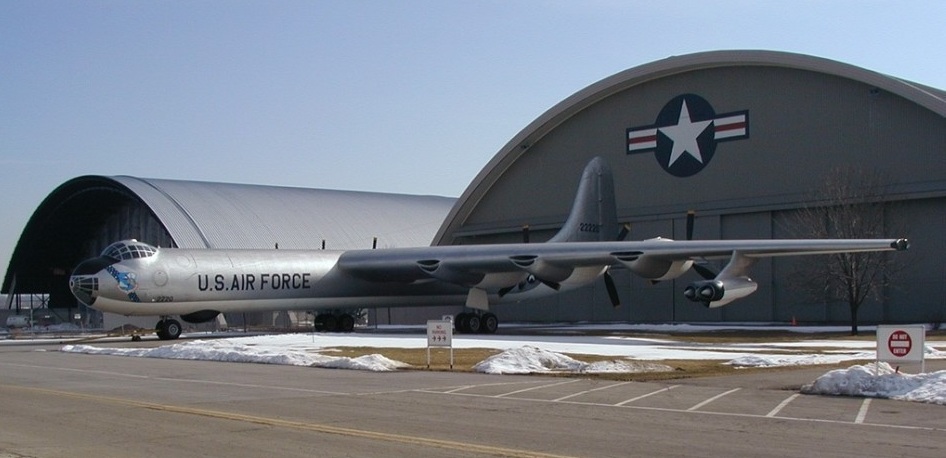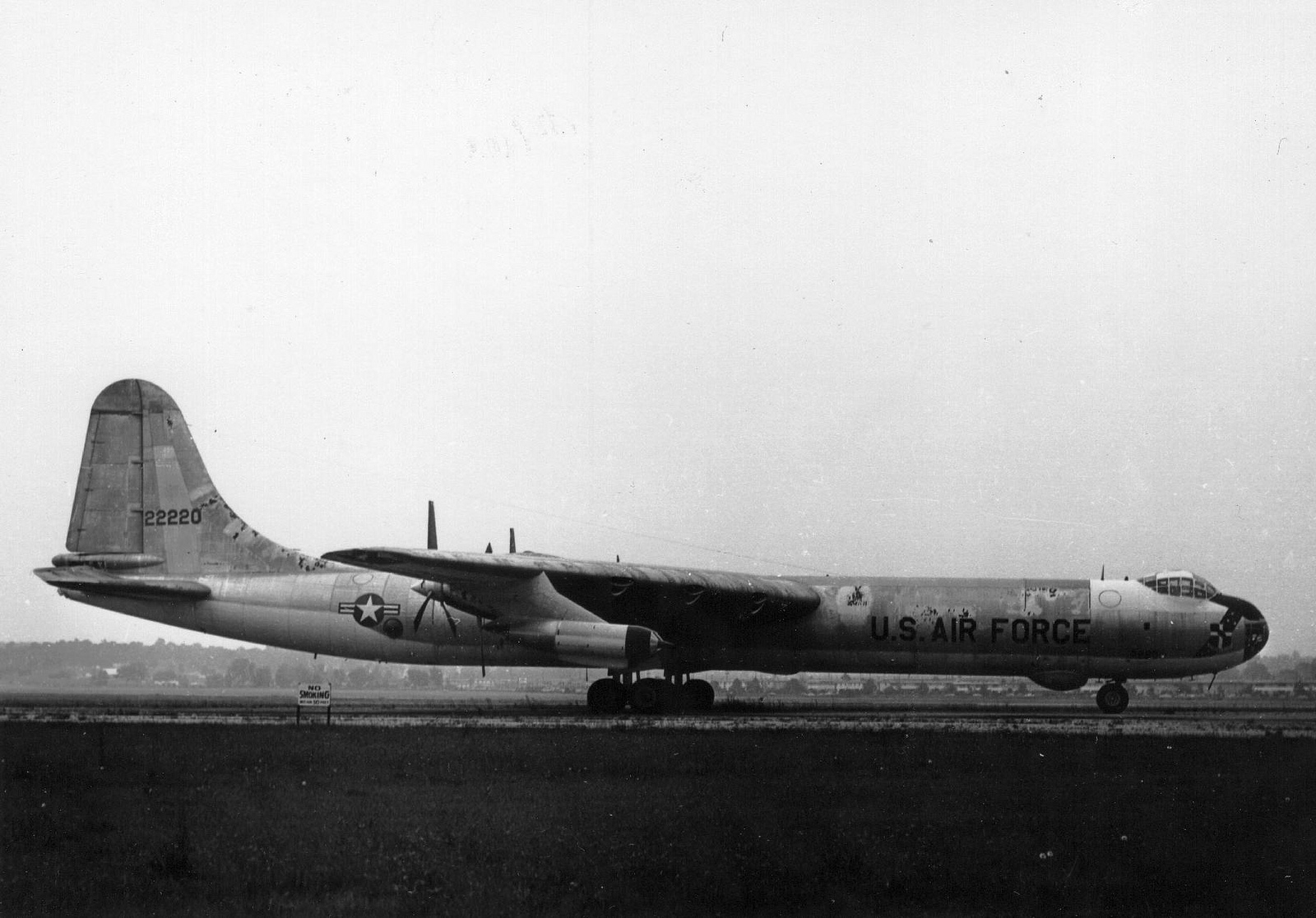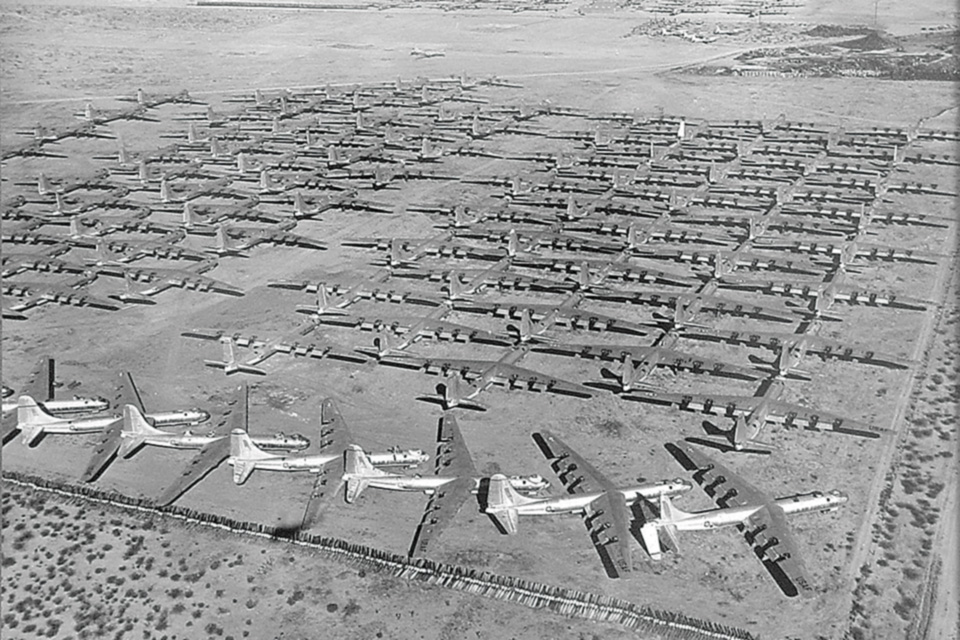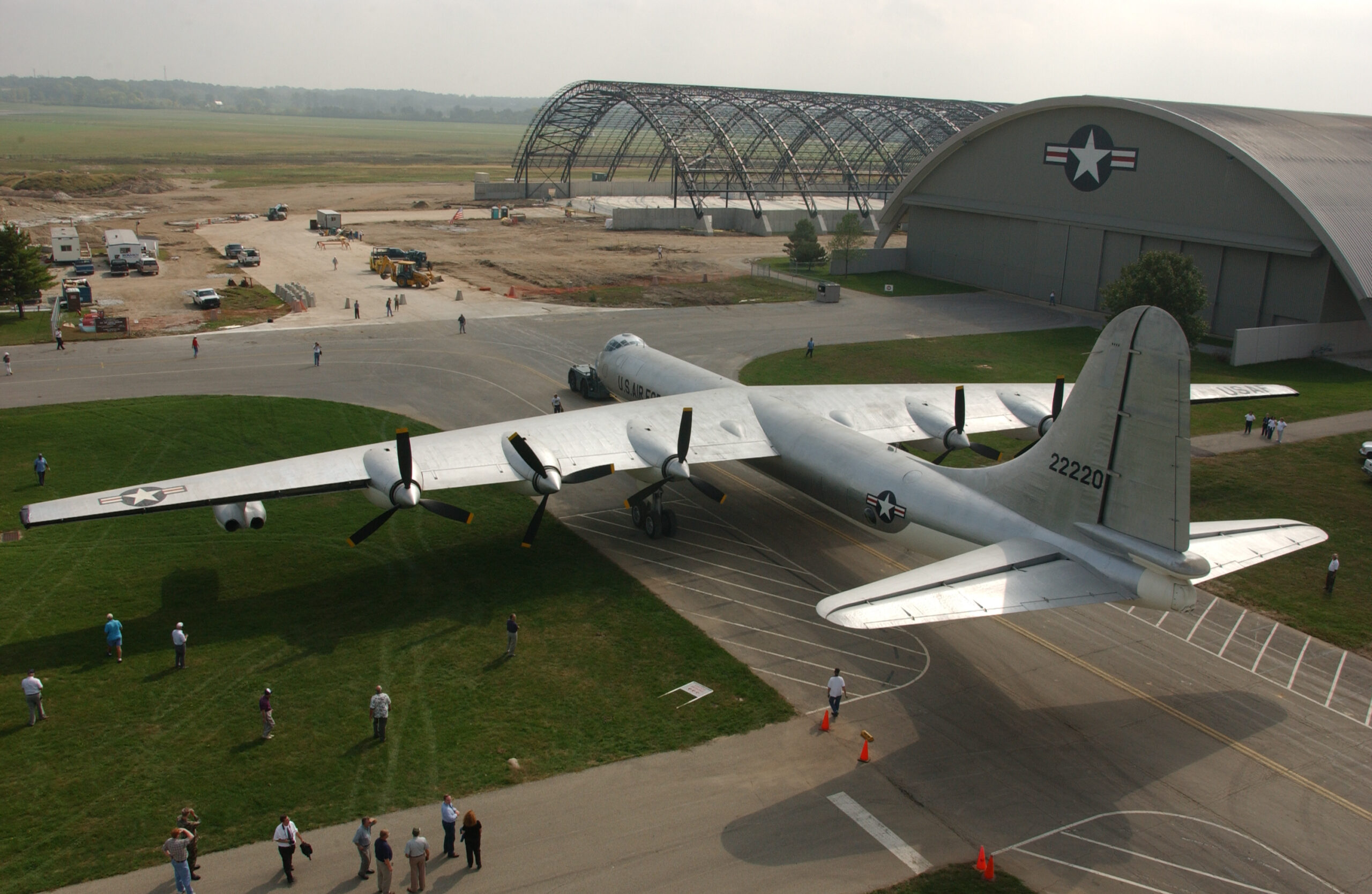
30 April 1959: Convair B-36J-1-CF Peacemaker, serial number 52-2220, landed at Wright-Patterson Air Force Base, Dayton, Ohio, completing the very last flight ever made by one of the giant Cold War-era bombers. It is on the collection of the National Museum of the United States Air Force.
![]() Convair B-36J 52-2220 was among the last group of 33 B-36 bombers built. It was operated by an aircraft commander/pilot, co-pilot, two navigators, bombardier, two flight engineers, two radio operators, two electronic countermeasures operators and five gunners, a total 16 crewmembers. Frequently a third pilot and other additional personnel were carried.
Convair B-36J 52-2220 was among the last group of 33 B-36 bombers built. It was operated by an aircraft commander/pilot, co-pilot, two navigators, bombardier, two flight engineers, two radio operators, two electronic countermeasures operators and five gunners, a total 16 crewmembers. Frequently a third pilot and other additional personnel were carried.

The bomber is 162 feet, 1 inch (49.403 meters) long with a wingspan of 230 feet (70.104 meters) and overall height of 46 feet, 9 inches (14.249 meters). The empty weight is 171,035 pounds (77,580 kilograms) and combat weight is 266,100 pounds (120,700 kilograms). Maximum takeoff weight is 410,000 pounds (185,973 kilograms).
The B-36J has ten engines. There are six air-cooled, supercharged 4,362.49 cubic-inch-displacement (71.49 liter) Pratt & Whitney Wasp Major C6 (R-4360-53) four-row, 28-cylinder radial engines placed inside the wings in a pusher configuration. These had a compression ratio of 6.7:1 and required 115/145 aviation gasoline. The R-4360-53 had a Normal Power rating of 2,800 horsepower at 2,600 r.p.m. Its Military Power rating was 3,500 horsepower at 2,800 r.p.m., and 3,800 horsepower at 2,800 r.p.m. with water injection—the same for Takeoff. The engines turned three-bladed Curtiss Electric constant-speed, reversible propellers with a diameter of 19 feet, 0 inches (5.791 meters) through a 0.375:1 gear reduction. The R-4360-53 is 9 feet, 9.00 inches (2.972 meters) long, 4 feet, 7.00 inches (1.397 meters) in diameter, and weighs 4,040 pounds (1,832.5 kilograms).
Four General Electric J47-GE-19 turbojet engines are suspended under the wings in two-engine pods. The J47 is a single-shaft axial-flow turbojet engine with a 12-stage compressor section, 8 combustion chambers, and single-stage turbine. The J47-GE-19 was modified to run on gasoline and was rated at 5,200 pounds of thrust (23.131 kilonewtons).
The B-36J had a cruise speed of 203 miles per hour (327 kilometers per hour) and a maximum speed of 411 miles per hour (661 kilometers per hour) at 36,400 feet (11,905 meters) . The service ceiling was 39,900 feet (12,162 meters) and its range was 6,800 miles (10,944 kilometers) with a 10,000 pound (4,536 kilogram) bomb load. The maximum range was 10,000 miles (16,093 kilometers).

Designed during World War II, nuclear weapons were unknown to the Consolidated-Vultee engineers. The bomber was built to carry up to 86,000 pounds (39,009 kilograms) of conventional bombs in two bomb bays. It could carry the 43,600 pound (19,776.6 kilogram) T-12 Cloudmaker, a conventional explosive earth-penetrating bomb, or several Mk.15 thermonuclear bombs. By combining the bomb bays, one Mk.17 25-megaton thermonuclear bomb could be carried.
For defense, the B-36J had six retractable defensive gun turrets and gun turrets in the nose and tail. All 16 guns were remotely operated. Each position mounted two M24A1 20 mm autocannons. 9,200 rounds of ammunition were carried.

Between 1946 and 1954, 384 B-36 Peacemakers were built. They were never used in combat. Only five still exist.

© 2017, Bryan R. Swopes
Wonder why the one at Wright Pat is outside. It was inside every time Isaw it there, even when the B-70 was parked outside. It was in lefthand side of the “original” Museum building. With a Mig-15, an F-86 and an A-37 tucked underneath, among other things.
This is not a current photograph. I selected this photograph because the entire airplane can be seen. I believe that the B-36J is inside in the Cold War Gallery.
the caption below that photo says it is being moved from Bldg 1 to Bldg 3
I always enjoy reading stories about the B-36
It is such an interesting airplane. 🙂
Saying 5 still exist, is a stretch at best. Only 4 are still intact.
Museum of the USAF, Dayton, OH
Pima Air Museum, Tucson, AZ
Castle Air Museum, Atwater, CA
Strategic Air Command Museum, Ashland, NE
The only other one was last known to be in pieces in a private scrap yard.
Thank you, Kent.
I remember the one they had parked outside at Chanute AFB.
That’s the one that is at Castle now, I helped reassemble it there!
No. The airplane at the Castle Air Museum is an RB-36H-30-CF Peacemaker, serial number 51-13730.
The move to current hanger a few years back (pictured) necessitated the removal of the wing tips. So what is seen here is not quite a 230′ span. The plane few in from Davis-Monthan AFB, Tucson, AZ saving it from the scrappers. The original museum sample, the 1st prototype (571), was not kept. Has been in deteriorating pieces near Cleveland as Kent mentions above.
“Private scrap yard near Cleveland” = Wally Soplata’s collection. At least some of the parts of the B-36 have been acquired by an outfit calling itself “Motoart” and the skin pieces are transformed into “planetags”….
Thanks Bryan for your continued output of write-ups, I look forward each day to see what you’ve uncovered.
My dad was a pilot in the 5th AF, 345 BG, 501st sqdn “Air Apaches”, so anything to do with B-25s are of course, highly interesting.
Thank you, Tom. The B-25 has always been a favorite of mine, too.
The original museum was at Wright Patterson Area A. Which is about 6 miles away from its current location in Area B. The Area B location did not open until 1971 All planes were moved prior to that time. The B-36 was in the new museum Building 1 until Building 3 opened a number of years later.
Follow this link for a pic of the B-36 in it’s current location at the Museum of the United States Air Force.
https://www.kkraceshots.com/Non-Racing/Warbirds-Airplanes/National-Museum-of-the-United-States-Air-Force/i-VBbQ42X/A
The aircraft is housed inside, and had been for years. As far as I know it’s been inside since the museum was constructed at its curren location south of the organ location where it was outside.
Another at The SAC and Aerospace Museum near Omaha, Nebraska.
My Pop talked about witnessing a B-36 full load bombing demonstration at Eglin at one point. He described it as the plane entering at one end of the horizon dropping bombs and exiting the other side still dropping bombs. Amazing capacity.
The B-36 did not move from the old location to the new. The one displayed at the old museum was the YB-36. It was sold for scrap and later became the Soplata B-36 carcass after the museum acquired B-36J (52-2220) for display.
Mike, the bottom photograph shows the B-36 being moved.
It is amazing to me that all of the aircraft were fully retired in 1959 yet the last “new” one was delivered in 1954, only five years prior. That is testimony to the speed with which the jet age took over. I was privileged to be able to crawl through the cockpit of the one in the SAC museum on open cockpit days when the museum was at Offutt in ‘88 or so. Got to go in the B-29 as well.
I was stationed at WPAFB from 1969 to 1973. I was there when the old museum in Area A closed and the planes (except for the B-36) were towed a few at a time to the new museum. The current B-36 sat at the end of the runway in Area B until they started construction of the current museum.
nice pic. it was a tremendous effort from all concerned and a vital piece of the deterrent needed to contain any hostile forces.
One was almost planted all over Dayton (with bombs) before they figured out why the engines would quit when the wing would bow and flex in flight. Seemes the alimunum wires encased in rubber sheathing would separate when flexed and return to contact when wing returned to static. Breaks couldn’t be detected since the wire casing wouldn’t indicate any separation inside the flexing. DUH !
I’ve been to a B36 crash site in Newfoundland where BGen Ellsworth was killed
If anyone is really interested in what was going on at WP just after the war….check out “TEST FLYING at old Wright Field”. 72 Test Pilots and Engineers, 130 personal Stories. 80 different airplanes. Museum at WPAFB has the books available to the public.
The B-36 at Castle air museum was stationed at Ellsworth AFB in Rapid City SD and it was assigned to the 717th bomb squadron, (yellow band painted at the top of the fin). It went from there to Chanute AFB as a museum piece. When Chanute was closed it was broken down and hauled to Castle Muesum , I believe by train and reassembled there. I was on the crash crew at Ellsworth and remember many runway standby’s for emergency landings on that airplane. The lemon yellow stripe on the rudder.
I’m now 80 years old and I grew up in Memphis and Little Rock. I remember seeing a B36 flying over Memphis with a largec flight of P-51s following it.